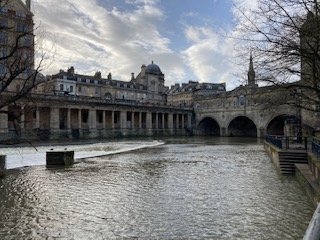24 February 2022
Bath in Winter
And an exhibition.
By Lynda Goetz

Bath is undoubtedly a lovely city. I am not sure though that February is the best time to see it. To be fair, it was certainly no worse than much of the English countryside in the middle of a series of innocuously named winter storms – Dudley, Eunice, Franklin – all hitting this island within a few days of each other. Here in our little corner of Devon we had trees down, branches smashed across narrow roads rendering them impassable and bits of roofing blown off barns and other farm buildings. Elsewhere there was more serious damage and flooding; three people were killed including one, rather surprisingly, not in the countryside, but in Highgate, North London when a tree fell onto the car in which they were travelling as a passenger. Few places were spared completely.
Although the storms caused us to revise our plans, driving over on Saturday morning rather than on Friday night, we went ahead with our visit to friends in Bath over the weekend. As we drove into Bath from the south west the famous honey-coloured stone looked damp, darkened and drab. Some of the small terraced houses looked as if they had definitely seen better days and we wondered idly how expensive and difficult it would be to bring these dwellings up to the EPC requirements that the government is gradually imposing on landlords and owners in order to be able to rent or sell such properties. Once we reached the more grandiose houses of the town centre, the rain-darkened buildings felt a little less oppressive and as the wind and rain eased up the afternoon held out somewhat more promise. After a light lunch in the grey and white elegance of our friends’ town house, we agreed on a walk to the Holburne Museum and a visit to the current temporary exhibition, The Tudors: Passion, Power & Politics.
The walk took us for part of the way along the Kennet and Avon Canal which runs through the city. Some seriously dilapidated barges graced its banks, as well as more commercial vessels which obviously ply their trade up and down the canal in more tourist-favourable seasons. We approached the museum from the Sydney Gardens side and were very impressed by opulent beds of assorted hellebores creating an unexpected bank of colour on a grey afternoon.
The Museum dates back to the late 19thC and is named after the man who bequeathed his collection to the city of Bath, Sir William Holburne of Menstrie (Sir William). The magnificent Palladian building in which it is housed was not, as many imagine, his home. It was originally built as the Sydney ‘Hotel’ and was a place of entertainment and relaxation for visitors to the Sydney Gardens behind. However, thirty-seven years after it was opened to the public in 1799 it became a private residence. It was not until 1916 that the building now known as the Holburne Museum was acquired to hold Sir William’s collection, which for years he had kept at No 10 Cavendish Crescent, a residence he shared with three spinster sisters.
In 2008 the architect Eric Parry was commissioned to add an extension at the back of the museum building, which now houses a café and some gallery spaces above. The glass and ceramic extension was controversial at the time and the design aroused a fair amount of local opposition. It was completed in 2011 and the openness of the space brings the gardens very much into this part of the building. The museum stopped charging an entry fee at that point and some websites erroneously state this still to be the case. It is free to under 18s and staff and students of Bath and Bath Spa universities as well as Friends, but the entry charge is now £12.50 including a Gift Aid donation. This gains the visitor entry to the entire museum including any temporary exhibitions and is valid for the day. When considered in this light and recognising the cost of maintaining and running a museum of this sort, it does, as the director Dr Chris Stephens points out, seem more honest and straightforward to approach the problem in this way rather than hoping that a donation box will prick the conscience of visitors.
Although there is a lot else to see, the temporary exhibition was our main reason for visiting on Saturday afternoon. Five Tudor monarchs were featured; Henry VII, Henry VIII, Edward VI, Mary I and Elizabeth I, as well as several of the other players in the drama of those times. The exhibition consisted of a number of portraits, mainly loaned from the National Portrait Gallery, several of which have never been shown outside London. Many were ‘unattributed’ and a number of others immediately recognisable as iconic images, including the portrait of Henry VIII after Hans Holbein and two of Queen Elizabeth I. There were portraits too of Sir Thomas More, Archbishop Cramner, ‘spymaster’ Francis Walsingham, the Earl of Essex, several of Henry VIII’s wives as well as one of the ‘nine days queen’, Lady Jane Grey.
The paintings were rich and textured and in many one had to marvel at the vivid reality of lavish brocades, silks, velvets and even the splendour of the chair on which Cramner, I think, was resting his arm. The exhibition was in a darkened area, presumably to protect the paintings themselves, but each portrait was skilfully lit. The explanations written up on the walls were simple and easy to understand, although most added little to insight of the period. It felt almost essential to have a certain amount of existing historical knowledge, preferably rather more than just a basic outline; otherwise those imperious gazes, cruel eyes or ruthless mouths might have meant little. I did however learn one extremely fascinating piece of information. The year after the celebrated defeat of the Spanish Armada (1588), the English sent its own fleet to the Iberian Peninsula. This English Armada or Drake-Norris expedition, which took place in 1589, was apparently a disaster from start to finish and the English suffered even greater losses than the Spanish had the previous year. Looking this up later, I discovered (from Reviews in History) that the reason most of us are unaware of this is that Elizabeth prohibited any publication about this catastrophe and allowed only a few propaganda pamphlets to be published, promoting a completely false picture of the events. Fake news has clearly been with us for a long time!


